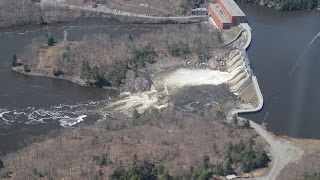The people most likely to be interested in these figures are the producers of hydro electric power in our region and the people vulnerable to floods. If there's too much or too little water flowing, one or the other of those groups is going to be affected.
 |
| Chelsea dam, Gatineau River |
The combined capacity of the hydro-electric generating stations in the watershed is over 4000 MW, producing over $1 million worth of energy on a daily basis.There are hundreds of dams and not all their effects are benefits. The Ottawa Riverkeepers list a few problems caused by dams:
- Blocking upstream and downstream migration of fish and mussels, thereby preventing them from reaching spawning and feeding areas
- Flooding, erosion, habitat washout
- Scouring and armoring of the riverbed by infrequent and large releases of water
- Rapid fluctuations in flow that do not mimic the natural flow patterns in rivers
- Modification of water-quality parameters including water temperatures, nutrient concentration and dissolved oxygen.
No comments:
Post a Comment